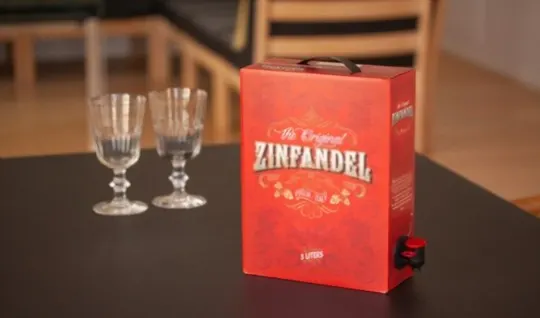Not many inventions, especially accidental ones, meet success initially.
In this case, we’re talking about white Zinfandel, which was created by accident.
Initially, it was labeled a cheap drink due to poor marketing in the 80s.
But with evolving times, its reputation changed gradually.
Many people confuse this wine with Rosé because of its classic pink color.
It often leads to questions like, “what does white zinfandel taste like” or “is white zinfandel and Rosé the same”.
If you have all these questions, perhaps this post can help.
Continue reading as we answer all the questions related to white Zinfandel.
What is White Zinfandel?

Before we get into white Zinfandel, let’s understand the aspect of Zinfandel.
It’s only fair to know the core of this wine which is created from one of a variety of grapes.
Zinfandel is a black-skinned grape with its origin in Croatia.
It’s a wine grape used mainly for making red wines.
Bob Trinchero and his team created white Zinfandel in 1972 through an accidental experiment.
The initial plan was to develop a deeper red and more potent red zinfandel wine.
The experimenting process led to the production of excess liquid with grape skins.
It was considered waste and was left sitting for multiple days.
However, they saw that the liquid had turned subtle pink.
So, instead of throwing it away, they decided to sell it as a rosé with a different name known as ‘white zin’.
What Does White Zinfandel Taste Like?

White zin is a refreshing drink with lower alcohol content consisting of 8-10% ABV.
Many assume that white Zinfandel is white wine, but surprisingly it’s not.
It’s a dry wine, meaning it’s not extremely sweet but medium.
Stuck fermentation is applied in producing dry wine, where the yeast absorbs the sweetness of the grapes.
Since all the sugars are not fermented, a lower percentage of alcohol is produced.
That said, let’s look into the taste profile of white Zinfandel.
This wine’s fermentation period is short; hence, it doesn’t have that pungent flavor.
Hence, the refreshing taste with a light flavor.
Note that the taste may vary depending on how winemakers produce it.
But the sweetness level remains the same, which is medium sweet.
The sweetness of this wine is similar to Moscato.
White zin has a fruity taste with a hint of raspberries, melon, citrus, strawberries, and a slight note of clove.
These are the primary flavors you’ll get while drinking this wine.
This wine has a low acidity level, so expect less sensation in your mouth.
The climate condition and the quality of the grapes play a crucial role in determining the taste of a wine.
Hence, expect variations in taste.
For instance, white zin from the warm region grapes has anise, pepper, and cherry flavor with a hint of blackberry.
In contrast, colder region grapes give strawberry and raspberry tastes.
White zin has a low-calorie level compared to most wines.
So, this wine would be perfect if you’re on a diet.
How to Serve White Zinfandel?

White Zinfandel is a versatile wine that allows you to pair it with various food items.
You can drink it alone but wouldn’t it be boring? So, to relish this drink to the next level, consider adding a side item.
It’s a light-flavored drink with fruity flavors.
It goes well with food items like salads, seafood, and chicken.
As stated earlier, the taste and sweetness of this wine may vary.
Therefore, it would be better to choose a side item depending on the sweetness level of your white zin.
Sweet zin
Sweet white Zinfandel goes well with a meat-based item like pork and beef.
You can also use it for glazing the meat to give it a sweet taste.
It also blends perfectly with creamy pasta dishes.
Soft cheese would be better if you plan to have it with this wine.
It complements the taste of the wine.
Additionally, cake and ice cream also make an excellent pair.
Dry zin
The sweetness level in dry Zinfandel is medium.
And side items like roasted vegetables or fresh salads blend perfectly with this wine.
Also, the smooth taste of this wine complements these side items.
Manchego and blue cheese make an incredible pair with this bold-flavored wine.
White Zinfandel vs Rosé

Many people think Rosé and white zin are the same.
It would be mainly due to similarity in color or the production method.
However, there is a difference in taste profile and flavor.
Rosé has different varieties with varying colors.
It can be sweet or dry. In contrast, white zin is sweeter and is devoid of complexity.
The color doesn’t vary and is pinker.
Another major difference between these wines is the usage of grape type.
Any red grapes can be used to produce Rosé.
However, zinfandel grapes are solely used for producing white zin.
When it comes to alcohol content, dry Rosé has a higher level than white zin.
In terms of health, both provide multiple benefits.
However, these wines contain alcohol regardless of the percentage level.
It would be better to have it in moderation to avoid implications for your health.
In conclusion, we can say white zin might perhaps be the little sister of Rosé.
The taste and color may vary, but it’s often classified under Rosé wines.
Depending on your taste and preferences, you can choose one.
White zin would be great if you prefer a fruity-flavored wine with lower calories.
Or if you prefer a higher alcohol content wine and less sweet, then choose Rosé.
Final Thought
Now that you know what white Zinfandel tastes like, perhaps you can give it a shot.
It’s a great introduction to wine if you’re a beginner.
You can get this from your local liquor stores or supermarkets.
Ensure that you have reached the legal age to drink this wine, as it contains a small percentage of alcohol.
Hopefully, this article clarified your doubts about white zin, its taste profile, and its differences from Rosé.
Both are delightful wines following a similar production process.

Leave a comment